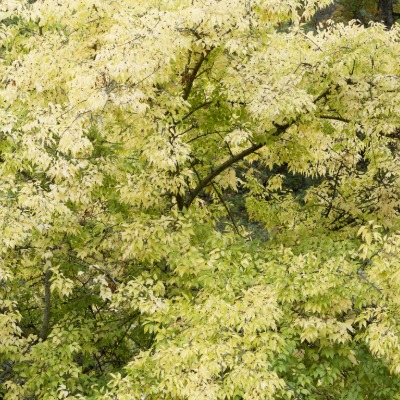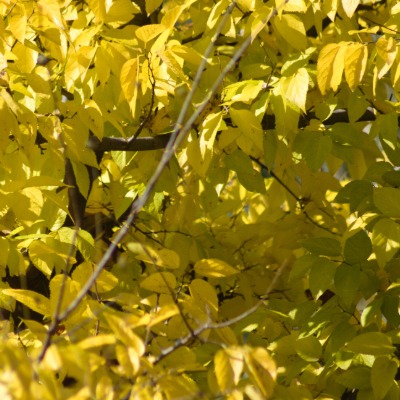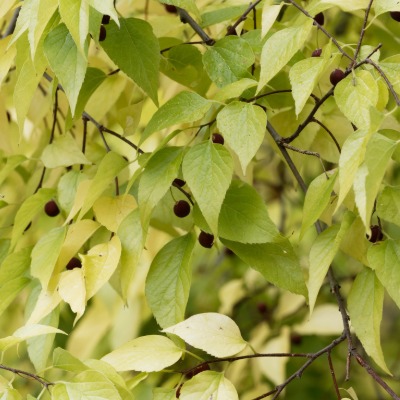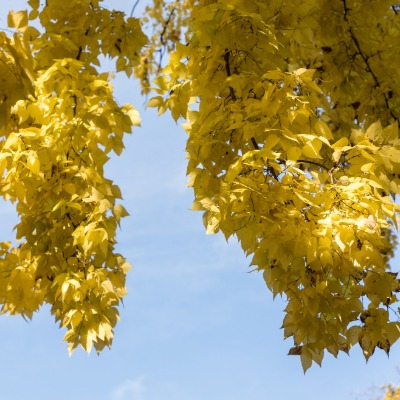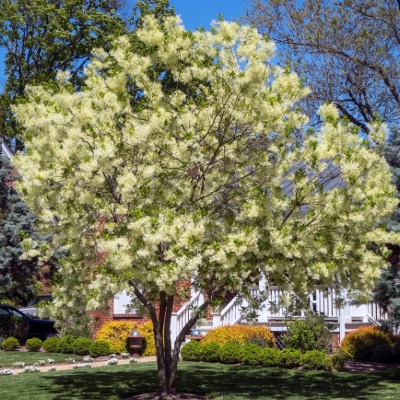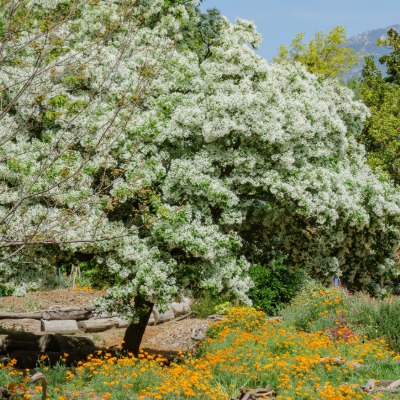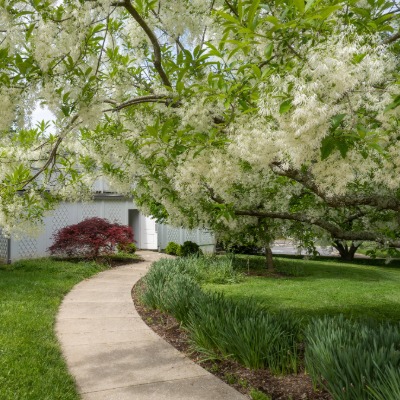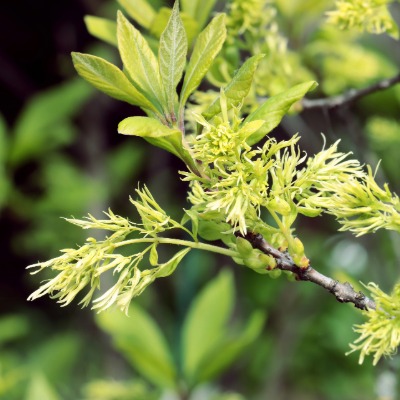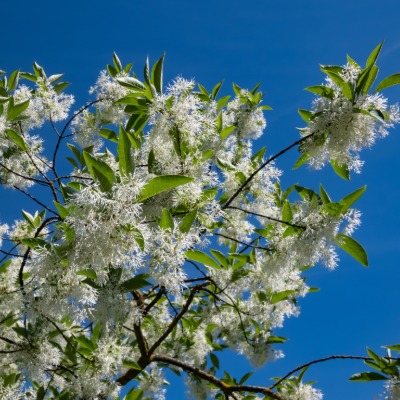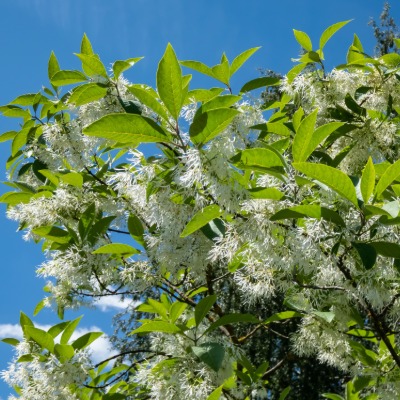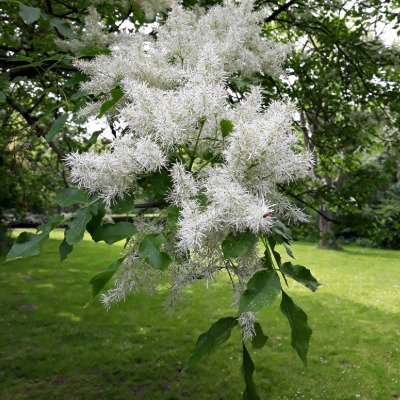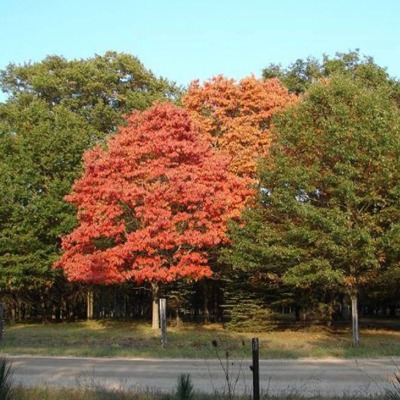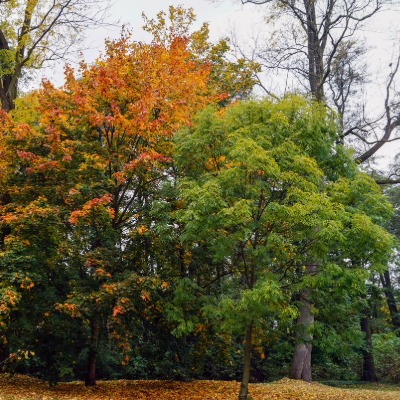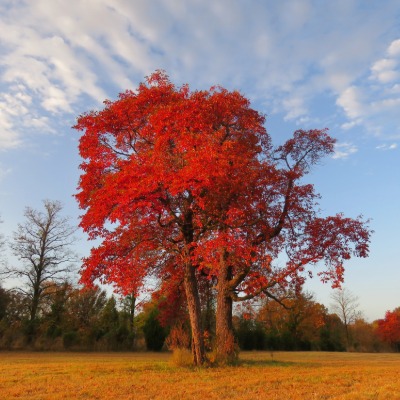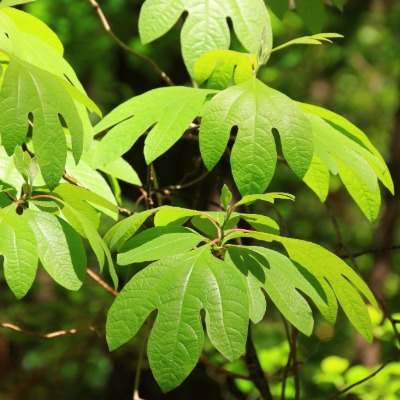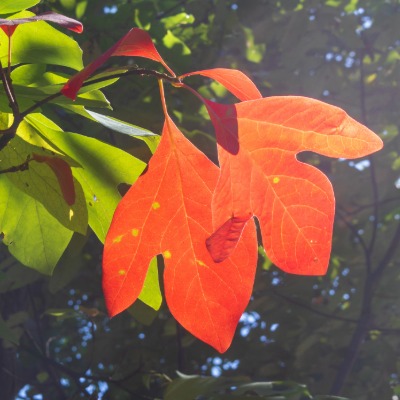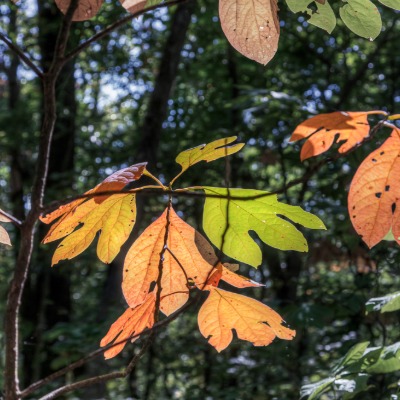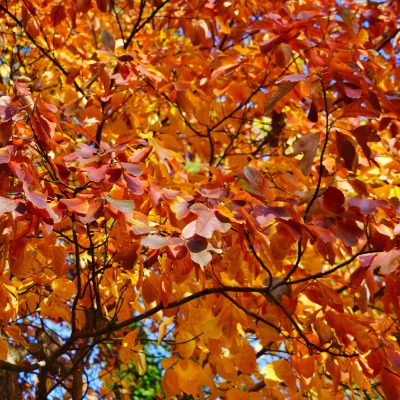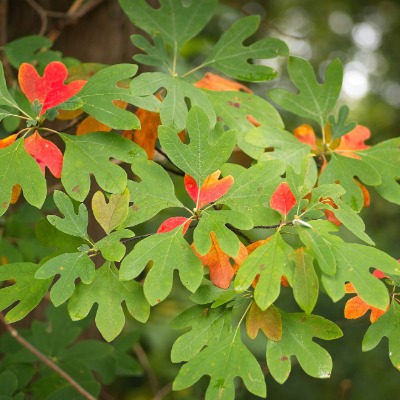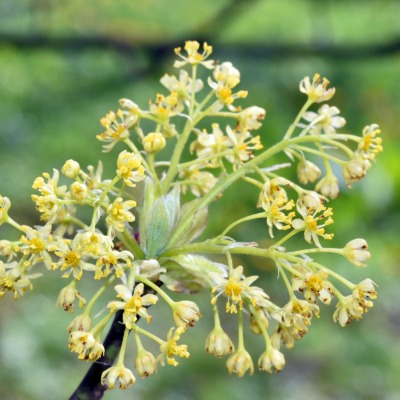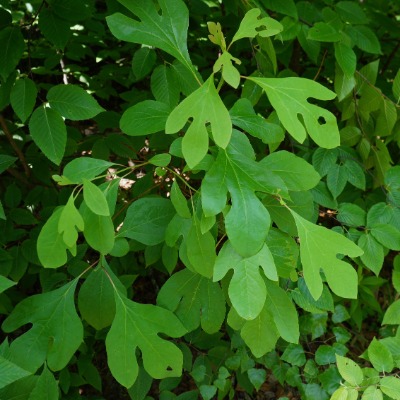MEDIUM TREES TO PLANT
COMMERCIAL LANDSCAPE MANAGEMENT - SERVICING MARYLAND, DC, AND VIRGINIA
PLANTING MEDIUM TREES
These are trees that grow up to 60 feet, cultivated for various ecological purposes such as erosion control efforts and promoting soil nutrient retention. They are a vital component of naturalization, creating habitats for local wildlife and enhancing biodiversity in urban areas. These towering trees serve as impressive focal points in large gardens or parks, providing shade and creating a sense of permanence and grandeur. They serve as natural barriers with their dense canopies, offering privacy, acting as windbreaks, and reducing heat and noise in urban environments.

The American Beech leaves are arranged in an alternating pattern along the branches, and their texture is smooth with prominent vein patterns starting off light green, then turning orange in the fall. It has a smooth, gray bark, and its trunk is sturdy and grows to a significant height. The branching occurs at a high point on the trunk, creating a rounded canopy that spreads out. In spring, its leaves emerge with a fresh green hue, which then deepens during the summer months. The foliage changes to a vibrant mix of yellow and orange tones in the fall until it curls and lingers on the branches in winter. Commonly used in woodland borders and groves. With its extensive root system, it is suitable for planting near structures as a focal point. Proper maintenance is recommended to prevent leaf and bark diseases.
TYPE
deciduous
HEIGHT
50 - 70 feet
SUN
full sun / part sun / shade
SOIL
moist
PURPOSE
ornamental and ecological

The American Holly is a widely recognized evergreen that features bright red berries and glossy green spiny leaves. This tree blooms small, white, subtly sweet flowers in the spring. To produce berries, it requires both male and female specimens planted in proximity to each other. The berries emerge in the winter months, providing pops of color when other plants have lost their foliage. The bark is smooth and gray, and develops a pyramidal shape as it matures. It can be used as a specimen tree, planted along walkways as a hedge, near entrance points, or as part of a mixed shrub border.
TYPE
evergreen
HEIGHT
50 feet
SUN
full sun / part sun / shade
SOIL
moist / dry
PURPOSE
ornamental and ecological

The American Persimmon has glossy, elliptic leaves with a vibrant green hue, transforming into striking shades of yellow and orange in the fall. The bark is typically gray or brown with deep furrows. The alternating branching pattern forms a semi-open and rounded canopy. It requires male and female specimens to produce fruit that start green and mature to a rich orange, reddish purple, or yellow color, ripening in late fall or early frost, turning sweet, flavorful, and suitable for wildlife and human consumption. This hardy plant can withstand various pests and diseases, making it an excellent choice for parks and public gardens, to residential yards.
TYPE
deciduous
HEIGHT
35 - 60 feet
SUN
full sun / part sun / shade
SOIL
moist / wet
PURPOSE
ornamental and ecological

The black willow tree, with its narrow and pointed leaves, creates a graceful silhouette that sways gently in the breeze and gives a sense of tranquility. It has a prominent trunk with dark, furrowed bark and a branching pattern that creates a graceful weeping canopy. The yellow-green catkins emerge in early spring, attracting pollinators. The tree is well-suited for areas with moist soil, and the roots are known for their aggressive growth as they seek out moisture, making them ideal for flood-prone or low-lying areas, close to water features like streams or ponds, where they can thrive and help with soil stabilization without causing structural issues to underground plumbing.
TYPE
deciduous
HEIGHT
20 - 35 feet
SUN
full sun / part sun
SOIL
moist / dry
PURPOSE
ornamental and ecological

The blackjack oak has lobed, dark green foliage that forms a dense canopy. The bark features a dark, rugged texture, ranging from deep gray to black. Its canopy is often broad and rounded, providing ample shade. In the spring, its leaves emerge with a vibrant green hue that deepens as summer progresses, offering shade and comfort in outdoor areas. Known for its striking fall color, its leaves transform into a spectacular display of deep reds and oranges, creating a visual spectacle. The tree prefers sandy soil, making it an excellent choice for woodland borders and driveways away from buildings.
TYPE
deciduous
HEIGHT
20 - 40 feet
SUN
shade
SOIL
dry
PURPOSE
ornamental and ecological

The Chinquapin Oak features lobed green leaves that turn a striking red fall color. In the spring, its lush green leaves emerge, creating a vibrant canopy that continues through the summer, transforming into a display of rich gold and red-orange hues in the fall. The branching pattern tends to be open and wide-spreading, allowing for a significant amount of light to get to the ground level, which can be beneficial for underplantings with other vegetation. The bark has a light gray color and smooth texture, and the small acorns are the sweetest among other oaks. Its expansive canopy and low branches provide shelter for various wildlife species. When strategically placed, this moderately sized oak tree can also help with windbreaks and erosion control.
TYPE
deciduous
HEIGHT
40 - 60 feet
SUN
full sun
SOIL
dry / moist
PURPOSE
ornamental and ecological

The Common Hackberry leaves are wavy with a serrated edge and a rich green color that turns a beautiful yellow in the fall. The tree forms a wide, rounded canopy and has a corky, warty texture on its bark. Its branches can spread very wide and should be placed well away from structures. In spring, the green leaves emerge and mature into a deep, rich green in the summer, turning yellow and orange hues in autumn, then shed their leaves in the winter, revealing an enchanting silhouette of branches. The flowers emerge with the leaves, the males forming white racemes and the females forming single greenish blooms. The berries, which ripen in early fall, are a small, edible drupe consumed by birds, and their dense canopy provides habitat for wildlife and ample shade that cools nearby structures.
TYPE
deciduous
HEIGHT
40 - 60 feet
SUN
full sun / part sun
SOIL
dry / moist / wet
PURPOSE
ornamental and ecological

The Eastern Red Cedar features scale-like leaves that are typically green to blue-green in color with a dense, pyramidal canopy. Its bark is fibrous and aromatic, with prickly needles when young that flatten as it matures. In spring, its lush green foliage emerges, providing a vibrant backdrop as it mellows into summer. The leaves take on warm hues of brown in fall and retain their rich bronze color in winter, creating a contrast against the starkness of the season. This evergreen tree serves as a nesting habitat and food source for over 54 species of backyard birds. Female and male trees are needed to produce blue juniper berries. They are commonly planted for screening or hedging and planted away from serviceberries and apple trees to prevent the spread of rust disease.
TYPE
evergreen
HEIGHT
30 - 60 feet
SUN
full sun / part sun
SOIL
dry / moist
PURPOSE
ornamental and ecological

The Flowering Dogwood, the Virginia State flower, is renowned for its stunning white or pinkish flowers, which feature a unique four-petal structure and emit a subtle yet pleasant scent. It blooms in spring with a tiered branching structure that forms a graceful canopy. The bark is often grayish-brown and has a rough, blocky texture that adds visual interest to the tree, especially during the winter months when it is devoid of leaves. As the seasons change, the foliage transforms into vibrant shades of red and purple in the fall. It is an excellent choice for both street plantings and as a specimen tree in shade gardens, serving as a beautiful focal point that enhances the overall ambiance of the space.
TYPE
deciduous
HEIGHT
20 - 40 feet
SUN
part sun
SOIL
dry / moist
PURPOSE
ornamental and ecological

The Fringetree is one of the last trees to leaf out in spring, but the striking visuals of its lush green foliage make it worth the wait. The white, fragrant, fringed flowers bloom in late spring and add an extra layer of beauty. The tree's canopy shape tends to be rounded and full on a smooth, light brown trunk. The fruits are small, oval-shaped, vibrant blue to dark purple colored drupes with a sweet, pleasant taste for birds and other wildlife. Its moderate size allows it to fit comfortably in gardens and patios in residential settings and to be utilized in riparian and conservation projects due to its adaptability and ecological benefits.
TYPE
deciduous
HEIGHT
20 - 35 feet
SUN
full sun / part sun / shade
SOIL
dry / moist
PURPOSE
ornamental and ecological

The hophornbeam leaves are elongated with alternating patterns and have a serrated edge developing into a rounded, dense canopy. The bark is smooth, grayish-brown exterior that becomes more textured with age. The branching pattern is notable for its zigzag form and is densely packed to provide coverage, and the hardwood makes it a durable tree, thus the other name "Ironwood". Its vibrant green leaves transform into a stunning display of yellow and golden hues in the fall. It produces small, inconspicuous flowers that bloom in the spring, followed by clusters of hard, nut-like fruits that resemble hops. The tree can be used as an understory tree beneath the canopy of larger trees in a forested setting and for ecological purposes, providing food and habitat for various species, and helping with soil stabilization and nutrient cycling.
TYPE
deciduous
HEIGHT
25 - 40 feet
SUN
full sun / part sun / shade
SOIL
moist
PURPOSE
ornamental and ecological

The Post Oak is characterized by its broad, lobed leaves with a deep green hue, which turns to a rich russet in the autumn months. The canopy is expansive and rounded, providing ample shade beneath its branches. It has a rugged bark that provides a sturdy exterior. The tree produces small, inconspicuous flowers in the spring, which are followed by acorns that serve as a food source for various wildlife. In the spring, its leaves emerge in a vibrant green that progresses in the summer. The leaves transition to rich hues of yellow and brown before they shed well into the winter. Its robust structure makes it resistant to various environmental stresses, allowing it to thrive in diverse soil types and conditions, used in soil stabilization, reducing erosion, and promoting healthier ecosystems.
TYPE
deciduous
HEIGHT
35 - 50 feet
SUN
full sun / part sun
SOIL
dry / moist
PURPOSE
ornamental and ecological

Sassafras trees are notable for lobed and mitten-shaped leaf patterns, which can vary on the same tree. The bark is gray to brown and features a rough, furrowed texture as the tree matures. The trunk grows straight and tall, the branches spread outwards, creating a rounded canopy. The tree produces small, yellow-green flowers in the spring, which are followed by blue, berry-like fruits that mature in late summer. In spring, the leaves emerge with a bright green hue, offering a refreshing look as they fill out and deepen in the summer before transitioning to shades of yellow, orange, and red in the fall. When allowed to colonize, their growth habit allows them to form thickets, which can be used in screening to provide privacy and reduce noise pollution.
TYPE
deciduous
HEIGHT
35 - 50 feet
SUN
full sun / part sun
SOIL
dry / moist
PURPOSE
ornamental and ecological

The Shumard Oak has lobed leaves with deep lobes that extend from a central vein, starting off as deep green and transitioning to a red-orange color in the fall. The bark is dark gray to black with shallow furrows and ridges. Its strong, sturdy branches extend outward, forming a pyramidal canopy when young and grow into an expansive and rounded crown as it ages. The tree produces small acorns, which mature in the fall and serve as a food source for various wildlife species. It is known for its stately stature and impressive fall color, when its leaves transform into shades of fiery red and orange. It supports environmental health through carbon sequestration and air purification, especially in grown specimens with larger biomass, making it an excellent street planting in urban areas.
TYPE
deciduous
HEIGHT
40 - 60 feet
SUN
full sun
SOIL
dry / moist
PURPOSE
ornamental and ecological

The Sweetbay Magnolia has long, elliptical leaves that are glossy green at the top and silvery green on the underside, which are aromatic when crushed. Its bark is smooth and grayish-brown. It can be single or multi-stemmed with an upright branching structure, allowing for a well-formed, rounded canopy. It is renowned for its fragrant, creamy white flowers that bloom in late spring to early summer. The tree produces elongated, cone-like fruits that contain seeds, which ripen in late summer and fall. In the spring, its large, creamy white flowers bloom and give off a citrusy vanilla scent. In the summer, the leaves remain lush and vibrant, while the flowers begin to fade, producing elongated, cone-like fruits. During the fall, the foliage turns yellow and gradually turns brown. It can be semi-evergreen with most leaves remaining in the winter. Cultivated as a focal point and specimen tree, its shrub-like growth is an effective screening tree and a natural barrier.
TYPE
deciduous
HEIGHT
40 feet
SUN
part sun
SOIL
wet / moist
PURPOSE
ornamental and ecological

The Virginia Pine features short twisted dark green needles that grow in pairs. The bark is typically reddish-brown and scaly. It has irregular branching and an open canopy structure that allows light to filter through. The coniferous tree produces small, cylindrical cones that take up to two years to mature and remain attached to the tree for several years. As fall approaches, the foliage may exhibit a subtle shift into a yellow hue. Its deep root system enhances groundwater recharge and prevents water runoff. An effective carbon sink, the Virginia Pine forests effectively sequester 40% of the state's carbon emissions, filtering air pollutants and improving overall air quality. Planted as a specimen tree and an outdoor Christmas tree during the holidays.
TYPE
evergreen
HEIGHT
30 - 60 feet
SUN
full sun
SOIL
dry / moist
PURPOSE
ornamental and ecological

The Yoshino Cherry Tree leaves are finely serrated edge oval-shaped, with a glossy, dark green appearance that transitions to a vibrant autumn hue of yellow and oranges. The bark has a smooth, light brown surface that matures to a slightly darker shade as it matures. Its graceful branching structure forms an open, expansive canopy with its dense foliage and blooms. It is prized for its beautiful and delicate flowers that appear in spring, followed by small red fruits. The blossoms are followed by vibrant foliage during the summer months and transition to golden yellow and orange colors in the fall. Celebrated for its white blossoms that blanket the branches in early spring, it creates a picturesque scene, making it the ideal ornamental planting in streetscapes.
TYPE
evergreen
HEIGHT
30 - 40 feet
SUN
full sun
SOIL
dry / moist
PURPOSE
ornamental and ecological
Ready to discuss your vision?
Let's schedule a consultation!


























































